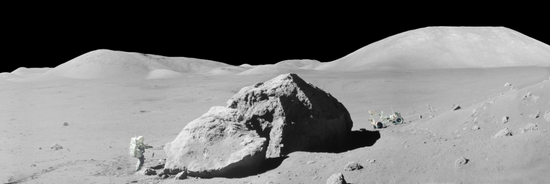Point of Contact
Background & Motivation
The Moon still poses many geological, geochemical, geophysical, astronomical, as well as physiological, and life science related research questions [1,2]. Amongst other research questions are volatile elements at the lunar poles, seismic measurements to investigate the lunar core, or radio-astronomy from the Moon. In the past, during Apollo, Luna, or Surveyor missions thermal or dust related problems were recorded [3].
The lack of knowledge on heat flux and transient rates for moving objects restricts technology development and the optimization of surface operations. This shortcoming is caused in part by a gap in the available software tools between randomized and sophisticated scientific lunar regolith models and engineering simulation tools for spacecraft design and operation. The TherMoS simulation approach starts to bridge this gap in combining lunar surface and spacecraft system thermal interactions.
Simulation
The TherMoS tool consists of topographic maps of the Moon, a lunar regolith model, boulder and crater models, an orbit propagator, a numeric solver, and a ray tracing algorithm, paired with spacecraft shape models, and the ability to include paths. The topographic maps are derived from Kaguya Laser ALTimeter (LaLT) data and Lunar Reconnaissance Orbiter (LRO) Lunar Orbiter Laser Altimeter (LOLA) data. The regolith model bases on a two layer approach from [4] and [5,6]. The regolith material properties are temperature and depth dependent and recalculated in each time step. Boulder and crater models base on literature in shape, size, and distribution.
Verification
Verification of the tool against LRO Diviner data showed deviations of less than ±15 K (±10%) for real landscapes such as Crater Calippus (Figure 1) and Crater Marius A, except for regions with presumably different material properties.

The following video shows the transit of a rover in front of a sunlit boulder for an angle of solar incident of 10° (high lunar latitudes or dusk and dawn). Shown is the balance of received and emitted infrared heat flux for every triangular surface element. In the diagram the sum of received infrared heat over all rover surface elements is plotted for the case with a boulder (blue line) and a reference case without any obstruction (black line).
Conclusions
This example illustrates the impact of local surface structures on passing spacecraft. The followed change in temperature obviously depends on the optical properties, the used materials, their connections, and the internal accommodation. Calculations with simplified rovers indicate that short transits through shadows impact the overall temperatures more than the same transits in front of sunlit boulders. Furthermore, the impact of surface structures (boulders and craters) is more pronounced towards lower sun elevation angles or lower environmental regolith temperatures, respectively.
The general implication for the design and operation for moving spacecraft and samples on the lunar surface currently investigated with the TherMoS tool, can also be translated to other atmosphere-less celestial bodies.
References
[1] Jaumann, R., Hiesinger, H., Anand, M. et al., 2012. Geology, geochemistry, and geophysics of the Moon: Status of current understanding. Planetary and Space Science, 74/1, 15–41.
[2] Crawford, I., Anand, M., Cockell, C. et al., 2012. Back to the Moon: The scientific rationale for resuming lunar surface exploration. Planetary and Space Science, 74/1, 3–14.
[3] Gaier, J. R., The effects of lunar dust on EVA systems during the Apollo missions, NASA/TM-2005-213610, Cleveland , Ohio, USA, 2005.
[4] Cremers, C. J., Birkebak, R. C., and White, J. E., 1971.Lunar surface temperatures from apollo 12. Earth, Moon, and Planets, 3/3, 346–351 <doi:10.1007/BF00561846>.
[5] Vasavada, A. R., Paige, D. A., and Wood, S. E., 1999.Near-Surface Temperatures on Mercury and the Moon and the Stability of Polar Ice Deposits. Icarus, 141/2, 179–193 <doi:10.1006/icar.1999.6175>.
[6] Vasavada, A. R., Bandfield, J.L., Greenhagen, B.T., Hayne, P.O., Siegler, M.A., Williams, J.-P., and Paige, D.A., Lunar equatorial surface temperature and regolith properties from the Diviner Lunar Radiometer Experiment, Journal of Geophysical Research, 117/8, <doi:10.1029/2011JE003987>, 2012.
